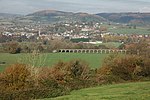Wyesham
Gwent geography stubsMonmouthshire electoral wardsVillages in Monmouthshire

Wyesham is a village and electoral ward in Monmouthshire, Wales. It is located less than one mile east of Monmouth, on the opposite side of the River Wye.
Excerpt from the Wikipedia article Wyesham (License: CC BY-SA 3.0, Authors, Images).Wyesham
Wyesham Road,
Geographical coordinates (GPS) Address Website Nearby Places Show on map
Geographical coordinates (GPS)
| Latitude | Longitude |
|---|---|
| N 51.807 ° | E -2.7 ° |
Address
Morrisons Daily
Wyesham Road 18-20
NP25 3JR , Wyesham
Wales, United Kingdom
Open on Google Maps








